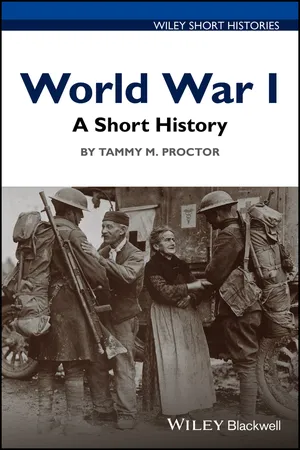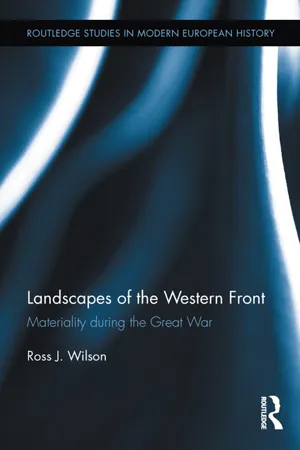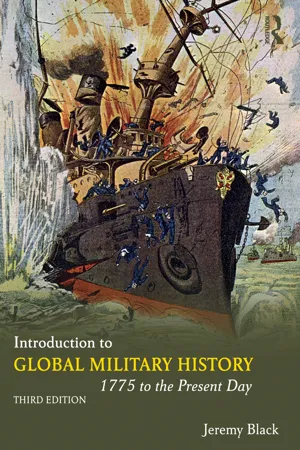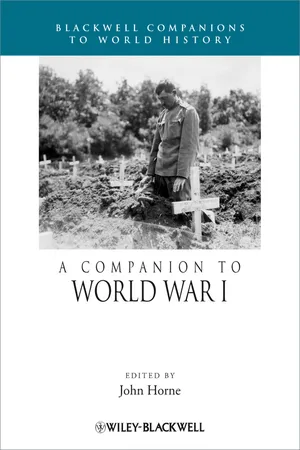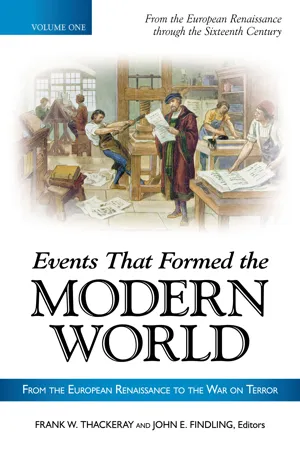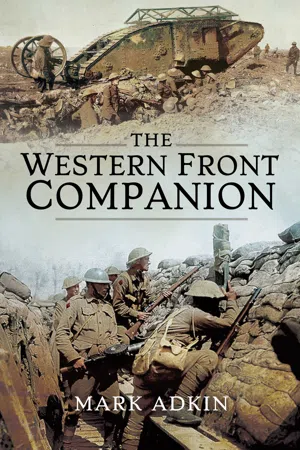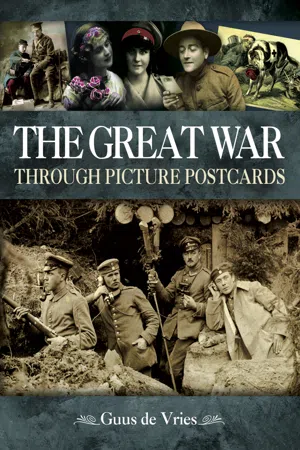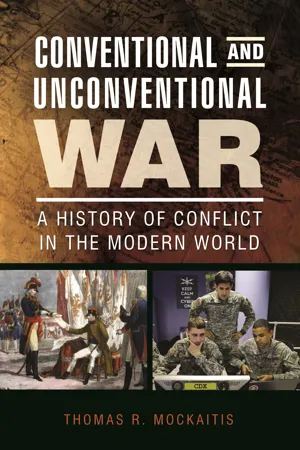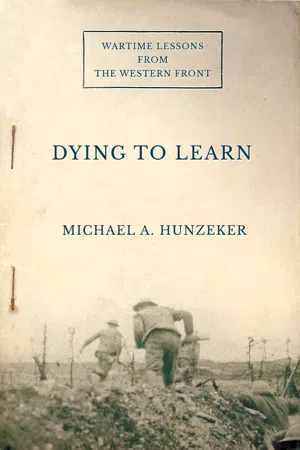History
Western Front
The Western Front refers to the main theatre of fighting during World War I, where the Allied Powers and the Central Powers faced each other in trench warfare across Western Europe. It stretched from the North Sea to the Swiss border and was characterized by brutal battles, high casualties, and a stalemate that lasted for several years.
Written by Perlego with AI-assistance
Related key terms
12 Key excerpts on "Western Front"
- eBook - ePub
Landscapes of Trauma
The Psychology of the Battlefield
- Nigel Hunt(Author)
- 2019(Publication Date)
- Routledge(Publisher)
12 World War I and the Western FrontThe Western Front. This is a rough indication of the length of the Western Front in the First World War, stretching from the English Channel to Switzerland. In the UK, we largely focus on the part down to the River Somme, a relatively short section of the whole line. The rest was held by French (and French colonial) troops for most of the war, with the United States joining in for the last few months (basically from September 1918). There are many sites beyond Ieper and the Somme that are worth visiting along the line.My father was born during World War I, and he was in the RAF from 1939 to 1945. I got to know him in the late 1960s, and from then until he died in 2012 his obsession was World War I. Even though he had fought throughout World War II, it was World War I that mattered to him. Like perhaps most people in the UK, his interest was centred around the Western Front. Furthermore, it was not the whole of the 440 miles of the Western Front from Nieuwpoort to the east of Dunkirk through to the Swiss border southeast of Belfort, but that relatively small section in Belgium and Northern France from the North Sea to the Somme, focusing in particular on those seminal battles of Ypres and the Somme, along with Loos, Lens, Arras, and so forth.A brief note on spelling. The place names in Flanders were commonly spelled in the French way (Ypres) and that is the way we usually know them when discussing World War I. In the modern world, the Flemish spelling is used more often (Ieper), so I have used the Flemish form when referring to the town, and the French form when referring to the battle.Ignoring the Eastern Front, the Italian Front, the Far East, Africa, and the sea war, World War I is, through British eyes, largely focused on this short stretch of the Western Front. I am also going to be guilty of ignoring the war in the rest of the world, but I will attempt a brief look at some other areas of the Western Front, largely fought over by the French and Germans, but also including the British (including the Empire troops) and the USA, for those who are interested in touring the length of the Western Front. - eBook - ePub
World War I
A Short History
- Tammy M. Proctor(Author)
- 2017(Publication Date)
- Wiley-Blackwell(Publisher)
3 1915. How and Where Was the War Fought?Figure 3.1The Western Front evokes images of endless trenches and destroyed environments. One strategy employed to stop the German Army’s advance in Belgium was the flooding of the battlefield by the Yser River. Here a sentry guards the flooded zone.Source: Photo of scrapbook page by author: Brand Whitlock Papers, Library of Congress.One of the most enduring features of World War I was the way in which it transformed landscapes. In the Julian Alps between Italy and Slovenia, one can still see the trenches carved into the mountainsides, while the rippled fields of the Western Front in Flanders continue to disgorge shrapnel, weapons, and other detritus of war. Not only were such physical landscapes reshaped but political, familial, psychological, and societal terrain altered during and after this conflict. New borders meant changing notions of personal and national identities, while the barrage of injury and death transformed households and villages. Therefore, for students wanting to dig into the war’s history it is important to understand the vast variety of these wartime landscapes. The next two chapters will explain these transformations by examining the spatial aspects as well as the human side of the geographical reshaping. By 1915 several zones of conflict had emerged as a result of the war, and in these zones the major transformations of the twentieth century emerged.For anyone taking a survey of the battlefronts in early 1915, the war looked static (see Map 3.1). Most of the offensives had stalled, winter had set in, and serious trench networks had emerged on both the Eastern and Western Fronts. Military and civil leaders alike began to consider the problem of “stalemate,” which was a term borrowed from the game of chess. In its original meaning, a player cannot move any pieces without going into check. This seemed a perfect description of the situation of the war by early 1915—no one could move without catastrophic losses, and normal strategies appeared illogical. Not only was stalemate a conundrum in terms of accomplishing any strategic goals, but it cost a lot of money to keep millions of soldiers in the field waiting for something to happen. Governments who were draining their treasuries began borrowing and taxing to finance the war. Action was needed, but the question of what action seemed an open one. Generals knew that outflanking maneuvers were impossible in most of the entrenched battlefronts of the war, so they faced either frontal assaults with great casualties or some other creative approach. Planners had several ideas for how to address the stalemate, and each in turn made an appearance in 1915. Every plan depended on the idea of a big breakthrough that would knock the enemy out of contention, and this concept remained a constant throughout the rest of the war. This led to experimentation in terms of military tactics and technologies. - eBook - ePub
Landscapes of the Western Front
Materiality During the Great War
- Ross Wilson(Author)
- 2013(Publication Date)
- Routledge(Publisher)
3 The Western Front, 1914–1918 INTRODUCTION This chapter details the broad history of the British Army on the Western Front, 1914–1918. It examines the geographical, logistical, multinational, governmental and social aspects of the British military in this sphere of conflict. This martial presence in northern France and Belgium during the Great War remains the largest endeavour undertaken by the British Armed Forces. The scale of operations was formidable; millions of men and women were transported from across the globe to occupy the myriad of vital roles required by the army. To support this endeavour, extensive networks of supply routes were organised from the Empire to Britain, across the English Channel and through the countryside of France and Belgium to ensure the functioning of the war effort (Horne and Kramer 2002; Chickering 2000) (Figure 3.1). The effect of these substantial systems amounted to a military occupation of the French departments of Picardie and Pas-de-Calais as well as Western Flanders. Indeed, a highly militarised landscape was formed within these regions. In this assessment it is important to maintain that, despite the significance and historical prominence attributed to ‘the trenches’, this was not the only environment encountered by individuals in the British Army. Rather, local towns, villages and farming communities, which were still inhabited despite the ravaging conflict, would have formed significant places for troops and labourers (see Gibson 2001). This chapter, therefore, presents a wider assessment of the British Army on the Western Front - eBook - ePub
Introduction to Global Military History
1775 to the Present Day
- Jeremy Black(Author)
- 2018(Publication Date)
- Routledge(Publisher)
CHAPTER 5World War One, 1914–18
▐ Introduction▐ Background▐ Opening campaign▐ Conflict within Europe▐ Warfare outside Europe▐ War at sea▐ Closing campaign▐ ConclusionsINTRODUCTION
World War One affects the public perception of twentieth-century conflict to a disproportionate extent, and the impression created focuses on the heavy casualties of the war on the Western Front in France and Belgium and the impasse of trench warfare. The perception of the war being static in every interpretation of the word is still prevalent today, and is often repeated in public, especially on television. There is little understanding of why stalemate developed on the Western Front, how it evolved or how it was resolved. The standard public view underrates the extent to which the war ended with victory, the total defeat in 1918 of Germany and its allies, by Britain, France, the USA and their allies. Given the difficulties of applying strength effectively, this was a more impressive outcome than is generally appreciated.BACKGROUND
Prior to the outbreak of the war, the General Staffs of all the European belligerents had pre-planned and executed manoeuvres on a massive scale in war games and staff rides. With these, staff officers convinced themselves that they could knock out their opponents before their own resources ran out. Although the defensive advantages resulting from the new breech-loading, smokeless, quick-firing firearms were understood, and the benefits of field fortifications, especially trench lines, had been shown in the Russo-Japanese War of 1904–5, there was a firm conviction within the General Staffs that sooner or later the supply of artillery firing high-explosive shells, combined with the élan of (their) infantry advances, would overcome trenches, barbed wire and automatic weaponry. Indeed, the somewhat limited trench lines seen prior to 1914, and in that year as well, did not encompass what actually happened during World War One. And the Russo-Japanese War did not suggest that such an evolution in trench systems might occur. In the Spanish–American War of 1898, the Russo-Japanese War of 1904–5 and the Balkan Wars of 1912–13, the attacking power had won. Although the Russo-Japanese War is usually cited as an indicator of what would happen in a future European war between the major powers, the actuality of the Western Front was quite different from the trench warfare of the Russo-Japanese War. While the power of the machine-gun was well demonstrated as was the power of artillery, the tactical perceptions of the observers did not suggest that infantry could not overcome machine-guns and artillery. Hindsight has suggested otherwise, because of what happened on the Western Front. - eBook - ePub
- John Horne, John Horne(Authors)
- 2011(Publication Date)
- Wiley-Blackwell(Publisher)
Trench warfare originated with the improvised defenses put in place by the infantry immediately after the battle of the Marne in September 1914, and with the “race to the sea” that lasted until the autumn. Exhausted by the enormous efforts they had made during the opening period, soldiers spontaneously dug “foxholes” to protect themselves from shells. These individual holes were progressively linked together and became the basis for the first trench lines. The German infantry, which was better trained at building field defenses, appears to have taken the lead in instigating a systematic trench network, earning the opprobrium of the Allies who accused them of degrading the traditional forms of combat. On the Western Front consolidation of front-line positions took place during the fall of 1914, creating a strategic impasse that would last for four years. Trenches developed on practically all fronts during the war. In the east, however, they only began to appear in December 1914 and remained relatively rudimentary. These positions, which were shallower and less organized than those on the Western Front, were more easily abandoned according to the movement of the different armies. Thus on the eastern front mobile warfare continued until the massive Russian retreat in spring and summer 1915, following which a static trench war emerged that was similar to that in the west.FirepowerWorld War I thus contributed to a definitive transformation of the techniques du corps (or bodily techniques) of the Western combatant.1 The trench system ensured the superiority of the defensive over the offensive. This was one of the main characteristics of World War I and it helps to explain the new intensity of the use of firepower on the battlefield that the conflict witnessed.The repeating rifle used by Western armies at the beginning of the twentieth century could fire over ten projectiles a minute in the form of fast, spinning, conical bullets across a target distance of around 600 m. These bullets caused extreme injuries, silently killing and wounding on a battlefield that appeared empty. Alongside the rifle, which was often awkward to handle in the trenches, the grenade came to play an increasingly important role in the soldier’s personal weaponry. Originally used in siege warfare, the first modern grenades were employed during the Russo-Japanese war, and this innovation aroused the interest of the German General Staff with the result that the German army had access to a large number of grenades at the opening of World War I. On the Western Front their use developed rapidly. Grenades required careful handling and armies soon developed grenadiers who were placed in the vanguard of attacks. They were a major element of infantry attacks in 1918, as revealed in the writings of Ernst Jünger, who described the massive use of grenades by assault troops.2 - eBook - ePub
Events That Formed the Modern World
From the European Renaissance through the War on Terror [5 volumes]
- Frank W. Thackeray, John E. Findling, Frank W. Thackeray, John E. Findling, Frank W. Thackeray, John E. Findling(Authors)
- 2012(Publication Date)
- ABC-CLIO(Publisher)
European expectations of a brief conflict were conditioned by the short and decisive Prussian campaigns against Austria and later France in 1866 and 1870–1871, which suggested that one Great Power could defeat another with relative ease. In retrospect, military planners should have taken their cue from the American Civil War, which dragged on for four years with staggering casualties. Of course, the first few weeks of campaigning in August 1914 conformed to expectations as the various armies jockeyed for position. An observer from the Napoleonic Wars would have recognized much. Cavalry still cantered at the head of columns, soldiers trudged on foot, horse-drawn carts laboriously pulled supplies. But once the German advance into France was stymied at the Battle of the Marne (September 1914), war on the Western Front settled into a prolonged and bloody stalemate.That stalemate reflected the fact that technological advances favored the defensive. Barbed wire, which had confined cattle on America’s Great Plains, proved even more effective in impeding the advance of men. Machine guns employed to deadly effect by imperialists in Africa and Asia were now turned with equal success against the soldiers of the European powers themselves. And the devastating bombardments of heavy artillery forced troops to burrow ever deeper merely to survive. By early 1915, parallel lines of German and Allied trenches stretched virtually from the Belgian coast to the Swiss frontier. The constant shellfire tore up the once pristine countryside, and the pitted terrain between the trenches, a morass of mud, corpses, shell craters, and tangled wire, appropriately became known as no man’s land.The contradiction between the initial dreams of a brief, glorious, and inexpensive victory and the seemingly ineffectual efforts of soldiers to win more than a few yards of blood-soaked ground at tremendous cost fostered disillusion, apathy, cynicism, and disgust. Like the myriad faces of war, the literature produced in response to the conflict was both varied and prodigious, ranging from outright nationalistic propaganda to realistic portrayals of battle to pacifistic appeals. Clergymen, physicians, and workers at the front became journalists, recording their personal experiences for posterity. In France, Dr. Georges Duhamel, a respected physician who voluntarily served for four years as a medical officer (his novels being translated into English as The New Book of Martyrs and Civilization ), and Henri Barbusse, whose Under Fire - eBook - ePub
Encyclopedia of Warfare
From the Earliest Times to the Present Day
- Adrian Gilbert(Author)
- 2013(Publication Date)
- Routledge(Publisher)
Germany and Austria banded together as the Central Powers, and were opposed by Russia and France. The other remaining European great power, Britain, was hostile toward Germany, and, while it had an informal arrangement with France, it remained outside the formal alliance system. Italy, on the other hand, was formally allied with the Central Powers in 1914 but remained neutral until 1915 when it officially entered the war on the side of France and Britain.Trench warfare, although not a new defensive tactic in battle, became the indelible symbol of World War I, especially along the Western Front. Here, French soldiers are dug in at Verdun, a battle that lasted nearly the whole of 1916 and claimed a million casualties.In August 1914, German troops marched into Belgium, as seen here entering Brussels. Although they progressed steadily at first, within a few months they became entrenched in a defensive line stretching from the English Chonnel in the north to Switzerland in the south. Both sides remained along this line, known as the Western Front, for the remainder of the war.The European alliances were initially intended to be essentially defensive in nature, but a series of international incidents – Morocco (1905), Bosnia (1908–09), and Agadir (1911) – increased tensions so much that the European powers became polarized into two armed camps. The army general staffs began to draw up plans for the probability of outright conflict.The strategic situation was geographically determined: Germany and Austria-Hungary held the center, “surrounded” by France and Russia, while Britain occupied a peripheral position. By 1912–13, Germany had become increasingly concerned by the rising economic might of Russia, its millions of miles of railroads – and therefore capability of transporting millions of soldiers relatively quickly – and the German General Staff began to advocate war before the Russian Army could take advantage of the relative decline in German industrial and military power. - eBook - ePub
- Gary Sheffield(Author)
- 2014(Publication Date)
- Oneworld Publications(Publisher)
5 1918: Crisis and Decision Western Front 1918 The war was finely balanced as 1918 began. Although Russia was out of the war, the Allies now included (as an Associated Power) the United States of America. While the USA had huge potential, its small peacetime army was undergoing massive expansion and would not be ready for combat until well into 1918. Although France and Britain had survived the gruelling year of 1917, the inconclusive and bloody Western offensives had led to war weariness on both the home and fighting fronts. The defeat of Russia by the Central Powers handed Germany the strategic initiative. It soon became obvious that the Germans were sending troops from the Eastern to the Western Front and preparing for a large-scale offensive that would complete their victory by forcing France and Great Britain to come to terms before thousands of American reinforcements could tip the balance in the Allies’ favour. Franco-British forces were thus compelled to go on the defensive and await the storm. At the end of 1917, Imperial Germany held the trump cards. One option would have been to open serious negotiations with the Allies, offer to restore territory captured in the west and then use the peace to exploit the vast empire Germany had carved out of the moribund Russian empire. Given the serious crisis on the home front and the problems being endured by its tottering allies, this would have been a sensible approach. However, Ludendorff and Hindenburg, effectively running the German government, decided in favour of the military option, a decision taken on, of all dates, 11 November: exactly one year later, the Armistice that ended the fighting on the Western Front would come into effect. The primary target of Operation Michael would be the BEF. With Britain defeated, it was hoped that the French would be forced to make peace - eBook - ePub
- Mark Adkin(Author)
- 2017(Publication Date)
- Pen & Sword Military(Publisher)
As the French became sucked ever more deeply into the defence of Verdun, so their capacity to fight alongside the British on the Somme diminished rapidly – as time progressed one of the objects of the BEF’s efforts in maintaining the offensive on that river was to relieve the pressure on the French at Verdun who were hard pressed to hold their own. In the event, the war on the Western Front in 1916 consisted of these two major offensives – the Germans at Verdun, a struggle that was to become the longest battle of the war; and the British (with some French support) attacking on the Somme, which became the most costly battle of the war.The fighting around Verdun lasted ten months, at the end of which the French had clung on to the town and had pushed the Germans back from some, but not all, of their initial gains. Both sides were utterly worn out and to an extent demoralized by crippling losses, highlighting the sheer horror of the destruction of men and material by modern war. The battle had ended in stalemate. On the Somme the fighting began on 1 July and ended in mid-November with the British and French having advanced a maximum of 7 miles, and with even greater losses than either side sustained at Verdun. There had been no Allied breakthrough.By the end of 1916 the Western Front had cost the BEF 600,617 casualties – well over twice the number for the previous year. For the Germans the year’s loss had been 297,351 - 2.7 times that of 1915. These horrific figures would be eclipsed by those of 1917, with 1918, the year the war ended, seeing the worst losses of all.A French View of Verdun A French officer at Verdun, Major Roman, wrote of the appalling scene at the entrance to his bunker:On my arrival, the corpse of an infantryman in a blue cap partially emerges from this compound of earth, stones, and unidentifiable debris. But a few hours later, it is no longer the same; he has disappeared and has been replaced by a Tirailleur [light infantryman] in khaki. And successively there appear other corpses in other uniforms. The shell that buries one disinters another. One gets acclimatized, however, to this spectacle; one can bear the horrible odour of this charnelhouse in which one lives, but one’s joie de vivre, - eBook - ePub
- Guus de Vries(Author)
- 2016(Publication Date)
- Pen & Sword Military(Publisher)
Chapter 5The Western Front
1914
T he first phase of the war in the west was shaped by the Schlieffen Plan, named after Alfred Graf von Schlieffen, who had died in 1913. Germany planned to avoid a war on two fronts by attacking along the northern flank through neutral Belgium, conquering the French capital, Paris, and gaining victory over France as a whole within six weeks. Afterwards, troops would then be free to move east for a war against Russia.But the German advance through Belgium was opposed by the strong fortifications on the Meuse river in Liège and Namur. The fortresses here were strong enough to resist the strongest guns that were in use at the end of the nineteenth century. Germany hoped that neutral Belgium would put up a symbolic resistance at most, and gave them an ultimatum on 2 August 1914. The ultimatum claimed that France was planning an attack against Germany across Belgian territory, and demanded Belgium must not hinder Germany’s defence. The king of Belgium denied this request and on 4 August, forces of the 2nd German Army entered Belgium.This posed picture shows Belgian soldiers in an imaginary fire fight against German attackers. In August 1914 Belgium could muster an army of 200,000 soldiers, who despite their mediocre equipment and training, put up an unexpectedly strong defence. The men wear leather hats that were later exchanged for French steel helmets. They carry the Belgian standard infantry weapon, the Mauser Model 1889 rifle.Belgian Army. Dog-drawn Maxim machine gun.In the late nineteenth and early twentieth century, the machine gun entered the arsenals of almost all armies. The basic model was developed by the American Hiram Maxim in 1886 and played an important role in the First World War. The roughly 25kg weapon was transported on pack horses or horse-drawn carts, but in Belgium (and for a short while in the Netherlands as well), dogs were also used as draft animals.Belgium mobilised an army of more than 200,000 soldiers. The army command, with the king at its head, had six infantry divisions and one cavalry division at its disposal, forming a field army of around 115,000 men. Approximately another 90,000 men manned the fortresses and fortifications, including those at Liège, Namur and Antwerp. Immediately after the German invasion, 20,000 volunteers reported for duty. - eBook - ePub
Conventional and Unconventional War
A History of Conflict in the Modern World
- Thomas R. Mockaitis(Author)
- 2017(Publication Date)
- Praeger(Publisher)
CHAPTER EIGHT World War IThe war that engulfed Europe and spread throughout much of the world from 1914 to 1918 was far more destructive than those who had so exhaustively planned for it could have imagined. A conflict that began between the Triple Entente of France, Russia, and the United Kingdom on the one side and the Central Powers of Germany and Austria-Hungary on the other expanded to include more than 25 other nations. During four years of war more than 65 million men took up arms, of which 8,528,831 million were killed and 21,189,154 were wounded.1 At least 6.6 million and perhaps as many as 9 million civilians also died.2 By the end of the war, four of the great empires that had fought it had ceased to exist, succeeded by a host of nations inhabited by their former subjects. The war cost an estimated $208 billion; caused an immediate postwar recession; and because of the debt it created, helped bring about the Great Depression that began in 1929.3 With such an enormous cost in blood and treasure, it is difficult to see how any nation, save perhaps the United States, which sprang to world economic dominance afterward, truly won the war. The conflagration illustrates the wisdom of Carl von Clausewitz’s maxim that “war is an instrument of policy” not an end in itself, which the Great War clearly became, as illustrated by the popular British slogan, “Damn the cost, we must win this war.”4Situated within the context of military history, the conflict represents a further step in the evolution of warfare. Since the time of the French Revolution conventional conflicts had become increasingly more extensive (with the exception of the wars of German and Italian unification) and more lethal. This evolution had been driven by three factors. First, technology had facilitated the creation of mass armies and equipped them with ever more lethal weapons. Second, ideology (largely absent since 1648) had been reintroduced into warfare by the American and French Revolutions. Wars fought for a cause have tended to be bloodier than those fought for limited political objectives. Nationalism had replaced religion as the prime motivator for international conflict, and wars fought on its behalf would prove to be far more destructive than any fought in the name of faith. Third, the second half of the 19th century witnessed the creation of mass conscript armies made possible by widespread social and economic change. The Industrial Revolution and its corresponding impact on agriculture meant that more men could be spared from peacetime occupations to fight. Patriotic indoctrination provided by free, compulsory public education gave them a cause for which to fight and die. - eBook - ePub
Cornell Studies in Security Affairs
Wartime Lessons from the Western Front
- Michael A. Hunzeker(Author)
- 2021(Publication Date)
- Cornell University Press(Publisher)
For Germany, operational speed came at a steep political and strategic price. The violation of Belgian neutrality gave Britain the casus belli to send its rapid-reaction force, the British Expeditionary Force, to France. For its part, the French Army’s rapid plunge into Germany—followed by an equally quick defeat—enabled it to fall back on Paris in time to block the German right hook. 1 Already hampered by logistical challenges, the German advance collapsed in the face of a combined French and British counterattack outside Paris near the Marne River. 2 British and French forces tried to exploit the Miracle on the Marne by launching a counteroffensive, but the attack failed to dislodge German units dug in near the Aisne River. With little room for maneuver to the south, all three armies shifted their focus north. A war that began with a race to Paris now turned into a Race to the Sea. 3 The two sides clashed as they moved toward the Belgian coast. After Belgian and French troops—supported by the British Royal Navy—blocked a final flanking movement by the German Army near the Yser River in mid-October, they ran out of room. From that point on, trenches stretched from the Swiss border to the Belgian coast. With no room to maneuver, the only sure way to win in the west was to punch straight through the other side’s lines. As most history books make clear, the proliferation of new rapid-fire weapons before the war—including breech-loading rifles, machine guns, and quick-fire artillery—were one reason maneuver gave way to trench warfare. These weapons made it easier to defend than to attack. 4 Defenders could pour fire into an attacker’s ranks while using trenches, shell holes, and pillboxes for protection. Advancing troops, on the other hand, had to weather an unprecedented storm of steel to press the attack. Firepower therefore helps explain stalemate on the Western Front. But it was not the entire story
Index pages curate the most relevant extracts from our library of academic textbooks. They’ve been created using an in-house natural language model (NLM), each adding context and meaning to key research topics.

